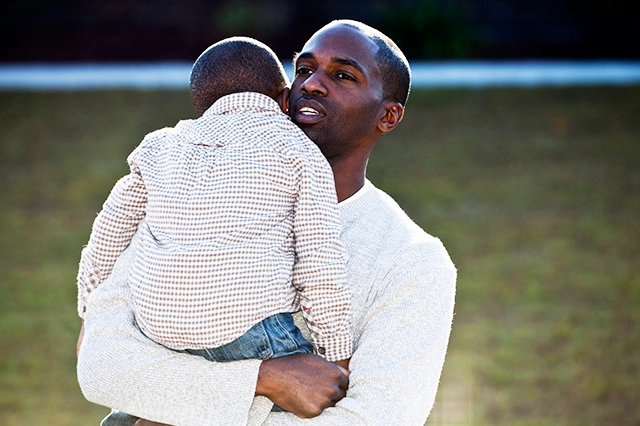Navigating change is a universal challenge, and moving homes is no exception. The whirlwind of boxes, logistics, and emotions can send anyone’s anxiety soaring. The essence of parent-child relationships that thrive during moves lies in open communication, empathy, and unwavering support. It’s time to explore ways black fathers can support their children during these pivotal transitions.
Riding the Waves of Change Together
Amid the confusion and chaos of moving, children look to their fathers for stability and comfort. This time is a paramount opportunity for black fathers to reaffirm their irreplaceable role in their children’s lives. A father’s steady presence becomes the anchor when families navigate the often tumultuous seas of change. Children’s anxieties and fears concerning the move find solace in the assuring embrace and understanding words of their fathers.
Caption: As a father, standing beside your children while they navigate the challenging waters of change demonstrates a united, supportive front.
Alt-tag: Father and his two kids lying on a bed together and taking a picture to symbolize the parent-child relationships that thrive during moves
These patriarchs are the pillars that hold the family structure firm, offering emotional and psychological support that is crucial in these transitional moments. By actively engaging in open conversations and ensuring their children’s concerns are heard and addressed, fathers can significantly mitigate the move’s impact, making the path smoother and more manageable. Their unwavering support lays a solid foundation for parent-child relationships that thrive during moves. Let’s explore it in more depth!

1. Keep the Conversation Going
Open lines of communication lay the foundation for parent-child relationships that thrive during moves. Fathers should encourage their children to express their feelings, concerns, and expectations about the move. Creating a space for dialogue alleviates children’s fears, providing them with a solid emotional base amid change.
In addition to addressing their concerns about the move, fathers can utilize this conversation to explain the moving process and what to expect, further demystifying the transition. Regular check-ins and conversations about the move can keep children feeling secure and understood, minimizing their anxiety and reinforcing their confidence in the face of change.
2. Embrace the New Together
Exploring the new neighborhood together aids in creating the happiest home environment for your kids. This approach creates anticipation and joy around the move, replacing anxiety with excitement. Fathers can ease the transition by pointing out nearby parks, schools, and other points of interest that will be part of their children’s new lives.
Fathers and children can work together to research local clubs, sports teams, or other activities to join, further enhancing the children’s anticipation and positive outlook on the move. This shared exploration reinforces children’s confidence and excitement about their new environment, making the move a positive and bonding experience.
3. Make Them Part of the Process
Involving children in the moving process is crucial in helping them overcome moving anxiety. By giving them responsibilities, like packing their toys or choosing their room colors, children feel valued and heard, reducing uncertainty and stress associated with the move.
Additionally, you can use this opportunity to discuss the importance of organization and planning, instilling valuable life skills. Taking the time to involve children in decisions related to the move, such as room arrangements or unpacking schedules, further solidifies their role in the family and importance in the moving process, reinforcing their emotional security and sense of belonging.
4. Establish New Routines
Stable routines provide comfort and security for children during moves. Fathers should establish and adhere to regular meals, homework, and bedtime schedules to ensure consistency in their children’s lives amid the change. This stability allows children to feel more in control and less anxious about the other changes happening in their lives.
Caption: Establishing new routines is a cornerstone in building parent-child relationships that thrive during moves, ensuring stability amidst the transition.
Alt-tag: Father and son hiking in the nature
Fathers can work with their children to develop these new routines, offering them a sense of agency and involvement in establishing their new daily schedules. This collaborative approach reinforces children’s emotional well-being and helps solidify their adaptation to their new environment.
5. Prioritize Their Education
Helping children to transition smoothly into their new schools is fundamental to helping them navigate educational challenges. Fathers should establish communication with the school and stay involved in their children’s academic lives to adapt to the new environment seamlessly.
Coordination with the new school’s counselors, teachers, and administrators allows fathers to stay informed about their children’s progress and any potential issues. You can actively participate in school events, parent-teacher meetings, and other school-related activities, demonstrating their commitment to their children’s education and providing additional support as they adapt to their new educational setting.
6. Focus on Healthy Conflict Resolution
Conflicts and disagreements can escalate during the stress of a move. Healthy ways to handle conflict and disagreement with your kids include maintaining calmness, listening actively, and validating their emotions. This approach fortifies the emotional bond, fostering resilience in the parent-child relationship.
Fathers should take the time to understand the root of their children’s feelings and work together to find solutions. This proactive conflict resolution reinforces children’s trust and confidence in their father’s support, ensuring that they feel heard and valued even amid the stress and change of a move.
7. Show Unconditional Love and Support
Displaying unconditional love and support assures children of their father’s unwavering presence, especially during significant life shifts like moving. This affection reinforces emotional security and resilience in children. This way, the parent-child relationship survives and thrives amid the move.
Caption: The beacon of a father’s unconditional love and support shines brightest in times of change, offering solace and unwavering reliability.
Alt-tag: Father holding and kissing his child
Fathers can demonstrate this support through regular affirmations of love and commitment and by being consistently present emotionally and physically during the move. Making sure your support remains steadfast amid the chaos of the move provides your kids with a vital emotional anchor. It truly helps them navigate the transition with confidence and security.
Navigating the Path Forward
As fathers and children embark on the adventurous relocation journey, adhering to these essential tips is pivotal. Keeping these guidelines at the forefront will solidify and robustly strengthen their bonds. The dad effect resonates. It ensures the pathway to a new home evolves into a bridge, fortifying parent-child relationships that thrive during moves.
The shared experiences, challenges overcome together, and the new memories etched in the annals of their lives will stand as testaments to the resilient and enduring bonds forged during the transition. Embark on this journey with assurance, love, and unwavering resolve to create a seamless, joy-filled move for both fathers and children. This way, you’ll secure a thriving relationship amid new beginnings.





